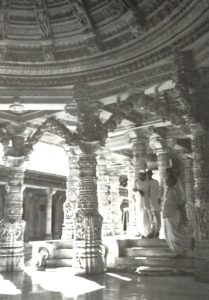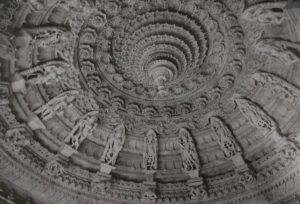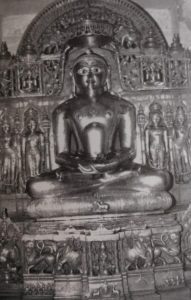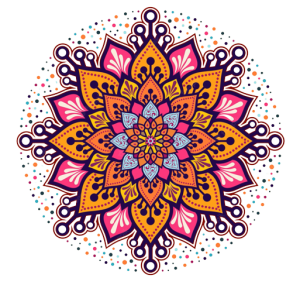Holy Abu
 It was holy Abu, first visited in December 1968, and the sight of the giant statue of Bahubali at Shravanabelagola early in 1969 that awakened in me the desire to return some day in order to see and learn more about a religious force capable of inspiring the human mind to envisage such grandiose works of art.
It was holy Abu, first visited in December 1968, and the sight of the giant statue of Bahubali at Shravanabelagola early in 1969 that awakened in me the desire to return some day in order to see and learn more about a religious force capable of inspiring the human mind to envisage such grandiose works of art.
At my first visit to Abu I was lucky enough to purchase one of the last copies of the 1954 English edition of the late Muni Jayantavijaya’s Holi Abu, about the best guide to this famous mountain. “Once upon a time.” to quote Muni Jayantavijaya, “the great Jaina monk Dharmaghosha Suri came upon Chandravati (the now devastated but once rich and famous city at the foot of Mount Abu; the editor) and at Vimala’s request, decided to spend the rainy season in this lovely city.
The day-to- day preaching of the monk led Vimala to introspection and deeply religious thoughts. Vimala ultimately requested the teacher to prescribe to him some act of atonement for the great sins of killing and such others committed in statecraft. The monk said that no prayashitta (rite for atonement of sins) was prescribed for sins committed knowingly and deliberately.
However, since Vimala had sincerely repented for them and asked for atonement, the teacher advised him to undertake repairs at Abu, the holy place of pilgrimage. Vimala decided to follow the advice and undertook the great task.”
Vimala, encouraged by his wife Shrimati, who was a devoted follower of the Jaina religion, aimed at something more lasting that what Muni Jayantavijaya wanted him to do. He decided to build a grand temple to Adinatha on Mount Abu near the village of Dilwara; and being an influential minister to the king of the Solanki empire.
he disposed of all the needs necessary for such an ambitious task. The consecration ceremony of the finished temple, today known as Vimala-vasahi (vashai- temple). was performed in 1032. The Hall of Elephants’ (hasti-shala) in front of the temple was added about hundred and thirty years later.
Two centuries after the construction of the Vimala temple, when the Solanki- dynasty was still reigning over Gujarat from the capital Patan, two ministers to king Bhima II, the brothers Vastupala and Tejahpala, erected a number of Jaina and Hindu temples of which the one at Dilwara on Mount Abu, known as Luna-vasahi or Tejahpala temple, is the most famous. It is stated that Tejahpala built this temple for the spiritual welfare of his wife and son.
In the central sanctum of Luna-vashai, a big seated Neminatha, sculptured in black basalt, was installed, the consecration of which took place in 1230.
A mere eight decades later, in 1311, these first two Jaina shrines at Dilwara were badly damaged by Muslim raiders. “All images of the Tirthankaras,” writes the author of Holy Abu, “were broken to pieces or badly mutilated and even the outer carvings.
Luna-Vasahi Temple. Dedicated to Neminatha 1230/31. Light and cleanliness are two characteristic aspects of the Dilwara Jaina temples on Mount Abu of the main sanc- fum and their front halls did not es- cape destruction.
” Thus, before pass- ing judgement on the artistic value of the Jina statues, it should be borne in mind that most of the Jinas wor- shipped in these and other temples are not the original ones but replace- ments made to or- der by the hand of non-Jaina sculptors at a time when the standard of the sculptural arts was on the decline.
Some ten years after the raid by Muslim invaders, a wealthy Jaina merchant by the name of Pethada led a group of pilgrims to the Dilwara temples and initiated to the Luna-vasahi shrine at his own cost; and since mutilated Jinas are not retained in Jaina temples, he installed a newly made image of Nemi- natha in place of the damaged one.
The date of erection of the Pittalahara temple, also known as the shrine of Bhima Saha, falls between 1316 and 1433 according to the author of Holy Abu. It was never.
 Luna-Vasahi, ornamental ceiling with pendant. White marble.
Luna-Vasahi, ornamental ceiling with pendant. White marble.
finished. Its attractions are the statues in both stone and metal, especially the image of Adinatha to whom the temple is dedicated.
The three temples of Dilwara so far mentioned are built of white marble. The chaumukha or chatur- mukha (four-faced) temple, placed outside the enclosure, consists of grey sandstone. Its probable year of completion is 1458/59.
Adinatha, cast in bronze; main image in the temple built by Bihma Shaha. A replacement of the original statue. It is a so-called pancha-tirthi, a sculpture showing five (pancha) Jinas with subsidiary figures.